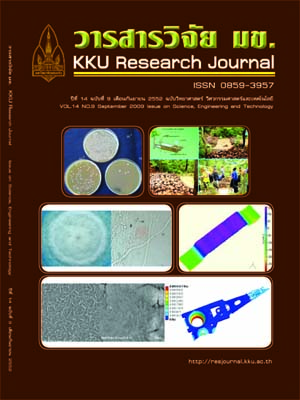Local wisdom promotion in Kok Panang Yai communal forest for Nampong watershed management (Thai)
Main Article Content
Abstract
Kok Panang Yai is a 2,000 rai (320 ha.) communal forest in its emerging revival period through villagersû work. A participatory action research was conducted for this project to enhance the existing roles of the community. Firstly, lessons learnt were passed on by older generations to young school children. Secondly, a survey on natural ditches was performed for dam construction to prolong humidity preservation in the forest areas. It was found there were 10 streams and about 3 main ditches which had high potential to construct check dams, which had never been done in this communal forest, comprising Rong-Hinlard, Rong-Namsai and Rong-Naloop. The research process also empowered some skillful active leaders as research facilitators who could spread information to other community groups. Thirdly, the two check dam's construction was performed by the community. They stored 35.0 x 3.0 x 0.8 cubic meters of temporary water. Preliminary results indicate that water was retained longer than previously from only a few days to 2 weeks. Additional studies collected rainfall and water flow rate in the creek, Huai Sainung. It was found that rainfall in August was heavy, and highest around 170 mm./day, during the period of storms. Water flow lasted around a couple of months in Huai Sainung and a peak was in early November, at 25 cubic meters per second, because farmers drained the water out of their paddy fields. It was found that the young community leaders were active and knowledgeable enough that they could be encouraged to be consultants for the Tambon Administrative Organization (TAO). They could handle in depth details of natural resources and environmental management (NREM) for better implementation, and to compensate TAO personnel shortages. Lastly, the setting up of a community based NREM unit is being considered to encourage a collective communal forest committee, water resource management groups, integrated farming groups and an environmental protection committee that was also important according to this research intervention.


